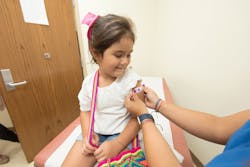Identifying disease pathways for personalized medicine in pediatric rheumatology
To date, not much is known about two similar, but different, pediatric rheumatic conditions: juvenile myositis, an autoimmune disease where the immune system attacks its own tissue and causes inflammation in the muscles, and systemic lupus erythematosus, the most common and serious form of lupus, where the immune systems attacks its own healthy organs, according to a news release from Michigan Medicine.
The most common form of juvenile myositis is dermatomyositis, which often presents first as scaly, swollen patches or a rash that appears on the skin before muscle weakness begins.
To better understand the differences in these two disease pathophysiologies, Jessica Turnier, MD, a Pediatric Rheumatologist at C.S. Mott Children’s Hospital and J. Michelle Kahlenberg MD, PhD, Rheumatologist at Michigan Medicine, teamed up with collaborators from Northwestern University Feinberg School of Medicine to come closer to bringing personalized medicine to the field of pediatric rheumatology.
Kahlenberg and Turnier’s study in Arthritis & Rheumatology found that juvenile myositis and lupus share a common type I interferon signature, meaning they share a common inflammatory pathway.
However, after analyzing and identifying differentially expressed genes in skin biopsy samples from 15 patients with juvenile myositis, 5 with lupus and 8 controls, lupus was found to have several more inflammatory pathways turned on compared to juvenile myositis, which only had a predominant type I interferon signature on.
“Both of these multi-system autoimmune conditions can look very similar, but the courses of treatment are quite different and in kids, persistent skin disease can indicate a more aggressive disease,” says Kahlenberg. “So it’s important to understand what’s going on in the skin, what the disease course may look like, and how aggressive we should be with immunosuppressive treatments.”
According to Turnier, JAK inhibitors, or disease-modifying anti-rheumatic drugs, target lupus and juvenile myositis’ common inflammatory pathway, offering potential therapies for the two in three affected children with chronic disease course waiting for clinical care developments.
Notably, an autoantibody found in some of the patients with juvenile myositis, anti-NXP2, was associated with a stronger type I interferon signature, which could be a reason for more serious disease in these kids.
Further investigation into the association of NXP2 autoantibodies and a stronger inflammatory signature may lend insight into the pathophysiological mechanism behind juvenile myositis.





